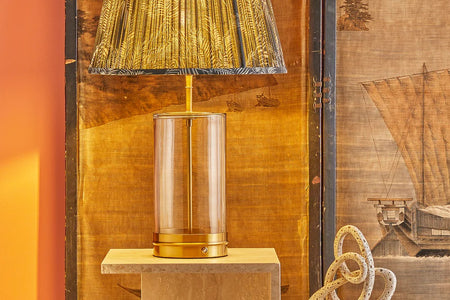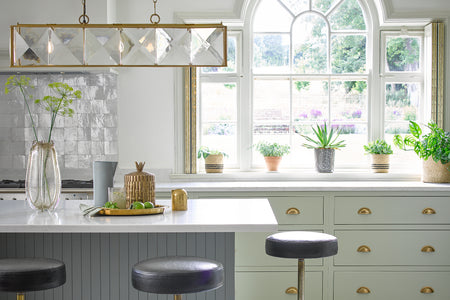
Warm lighting can change the way a space looks and feels – and even how we feel. Find out all you need to know about warm lighting in our guide...
Why is warm lighting so important?
Light, and specifically certain types of light, can affect us both physically and emotionally. In the past, our daily waking and sleeping patterns were closely bound to the natural rising and setting of the sun – and while we may have moved on in many ways since then, the same principles still apply when it comes to lighting.
As a general rule, bluish-white light appears brighter and cooler in tone and is more stimulating – which is why a bright sunny day makes us feel positive and energised. Meanwhile, yellow-white light is warmer and has a gentler, more calming effect: the warm glow from a fire or a set of candles creates a cosy, intimate atmosphere which naturally makes us want to slow down and relax.
When it comes to lighting, cooler light is ideal for helping to boost our focus and concentration during the daytime, and can be useful in practical spaces such as kitchens, bathrooms and workshops.
However, it’s essential to have some lower level warm lighting options available when it’s time to chill out and unwind. Warm lighting is particularly important in spaces such as the bedroom, living room and dining room, or any other space where you want to relax.

Using warm lighting to create mood and atmosphere
In a multipurpose space, such as a sitting room, you’re likely to need a variety of different kinds of lighting for different times of day.
There are three main types of lighting: ambient lighting, which is the basic general illumination in a room, including the main light; task lighting, which is practical lighting for specific tasks; and accent lighting, which is used for highlighting certain areas or features within a room.
The best lighting schemes use a combination of these different types of lighting – this is known as layering light, and it allows you to emphasise different aspects of your space at different times and for different purposes.
By layering your light, you can ensure you have plenty of cool, practical light during the daytime, before transforming your space into a cosy and welcoming environment with the perfect atmosphere for entertaining guests, or chilling out before bed.
While a pendant light or chandelier will provide plenty of good overall ambient light, adding in a combination of wall lights, floor lamps and table lamps will help to create a warmer and more intimate feel. And installing some dimmer switches will allow you to adjust your lighting to create exactly the right amount of warmth and atmosphere.

Using wall lights to create warmth and atmosphere
Wall lights and sconces offer a softer, more atmospheric alternative to overhead lighting and are a great way of adding a sense of warmth to a space – whether it’s a sitting room, a dining room or a bedroom.
A set of wall lights will create a gentle wash of soft, indirect light which is ideal for creating a warm and intimate feel.
Wall lights come in a wide range of different styles and shapes, including uplights (‘pointy uppy' wall lights) which cast the light upwards along the wall, helping to open up a space, and downlights (‘pointy downy’ wall lights) which send the majority of light downwards and highlight the horizontal space, creating a cosy, inviting atmosphere.

Creating warmth and atmosphere with floor lamps and table lamps
You can supplement your wall lights with a range of floor lamps and table lamps, to create an additional layer of soft, warm lighting.
As well as providing great ambient and task lighting, floor lamps are an excellent choice for creating atmosphere. A set of matching floor lamps spaced around the sitting room will provide a lovely spread of light and bring warmth to any dark corners. Meanwhile, a stylish floor lamp in the dining room will create a warm, intimate (and more flattering!) light for entertaining.
Floor lamps can also be used to highlight certain features or areas within a space – try placing a floor lamp or two inside alcoves, either side of the fireplace, or next to a sofa or favorite chair to create a warm and cosy zone.
Meanwhile, table lamps are ideal for adding atmosphere to a space and provide a lovely ambient glow. A selection of table lamps placed around the room at eye level will offer a warm and welcoming feel. Table lamps are also beautiful decorative objects in themselves and can add depth, colour and interest to your space.
Of course, it's not just the lamps themselves that can create warmth and atmosphere – your choice of lampshade also plays an important role. Lampshades come in a wide range of different colours and materials, all of which can affect the way the light diffuses.
A semi-translucent silk or linen lampshade will generate a beautiful warm, diffused light. Meanwhile, lampshades made from a more opaque material such as velvet are great for decorative and accent lighting as they direct the light up and down and will create a lovely pooling effect.
View Pooky’s huge range of affordable designer lampshades.

A guide to colour temperature
As we have seen, different types of light can have ‘warm’ or ‘cool’ qualities, with softer, yellow-white light signifying warmth and cosiness, while brighter bluish-white light tends to have a cooler, harsher feel. In modern lighting terms, the warmth or coolness of the light that’s emitted from a lightbulb is officially known as its ‘colour temperature’ and it's measured on the Kelvin scale (K).
Contrary to what you might expect, the lower down the colour temperature scale, the warmer the light! Toward the lower end are the warm reds and oranges, graduating to yellows, whites, blue-whites and deeper blues at the top end. Warmer yellow-white light features toward the lower end of the scale at around 2,500-3,000K, while candles and sunsets come in at a cosy 2,000K and under. Meanwhile, daylight is higher up the scale, with a colour temperature in the region of 6,000K.

Choosing the right colour temperature light bulb can make a big difference to the way a space works, as well as how it feels. While cool light is good for visual and practical tasks, too much of it can make us feel agitated and unsettled, and can also interfere with the body’s natural sleep-wake cycle (hence the 'no phones before bed' rule!)
To create a warm, inviting atmosphere in your living space you should aim to use warm white light bulbs in the 2,700-3,000K range – the lower the figure, the more yellow the light will appear. Whichever colour temperature you opt for, it’s a good idea to make it standard across the relevant light fittings, so you have a nice uniform light.
See also: How to choose a lightbulb - the complete guide
Pooky makes beautiful affordable designer lighting for beautiful rooms. Browse our lamps, shades, wall lights, pendants and more here.










